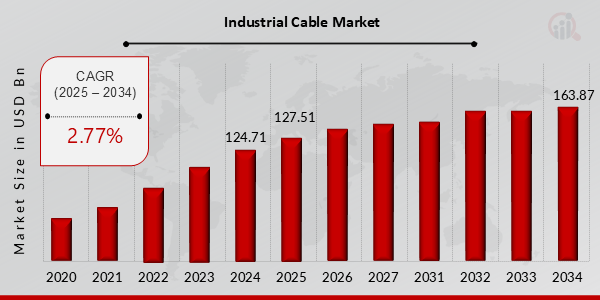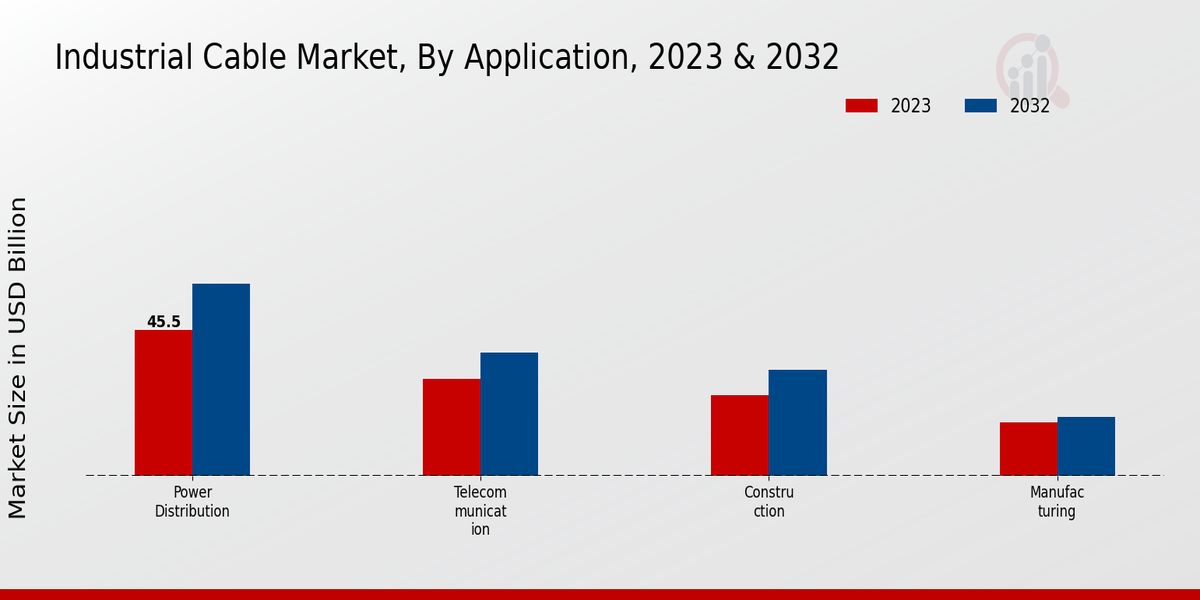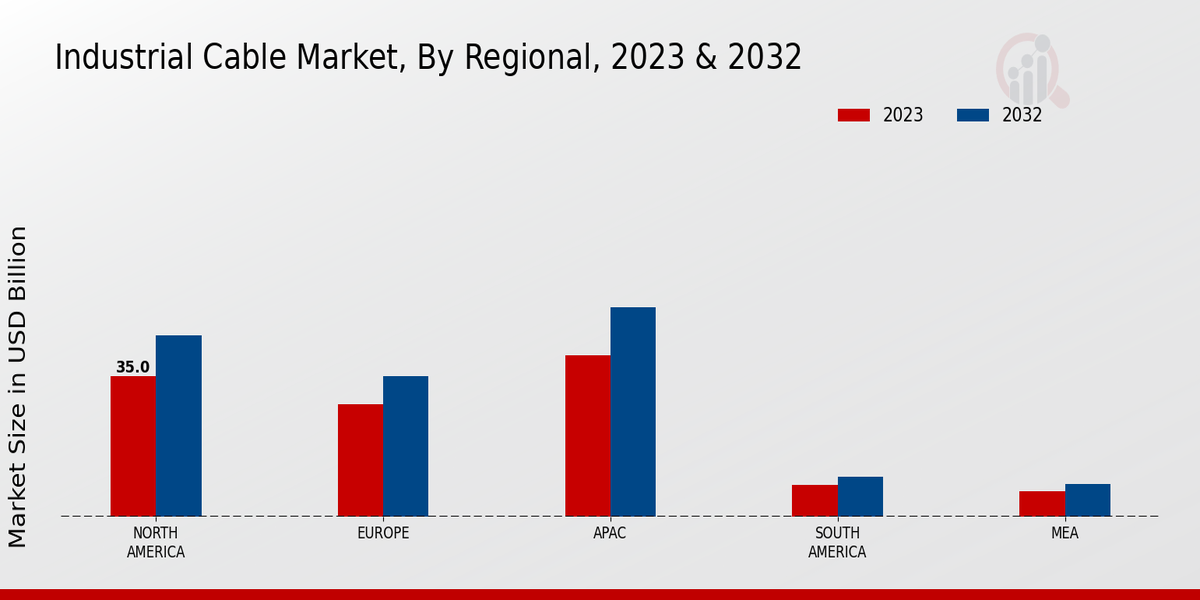Global Industrial Cable Market Overview:
Industrial Cable Market Size was estimated at 124.71 (USD Billion) in 2024. The Industrial Cable Market Industry is expected to grow from 127.51 (USD Billion) in 2025 to 163.87 (USD Billion) till 2034, exhibiting a compound annual growth rate (CAGR) of 2.77% during the forecast period (2025 - 2034).
Key Industrial Cable Market Trends Highlighted
The Industrial Cable Market is witnessing significant growth driven by the increasing demand for energy-efficient solutions and the expansion of infrastructure projects worldwide. A surge in automation processes in manufacturing and industrial sectors is further propelling the market as industries seek reliable and durable cable solutions to support their operational needs. The rise of renewable energy sources also plays a crucial role, with industrial cables being essential for wind, solar, and other sustainable energy applications. Additionally, the growing focus on infrastructure development in emerging economies presents opportunities for the market to tap into new customer segments and promote innovative products tailored to specific industrial applications.There are numerous opportunities to be explored in this evolving landscape. The growing trend of smart manufacturing and the Internet of Things (IoT) creates avenues for advanced cable solutions that integrate seamlessly with digital technologies. Companies that invest in research and development can create products that meet the specific requirements of industries, such as telecommunications and energy, leading to enhanced performance and reliability. The focus on sustainability also encourages manufacturers to innovate eco-friendly cables, aligning with the global push for greener solutions. Recent trends indicate an increased emphasis on the customization of industrial cables to meet varying operational demands across sectors.As industries evolve, the need for specialized cable solutions that can withstand harsh conditions or extreme temperatures has become more important. Moreover, the integration of technology into cable production processes enhances manufacturing efficiencies and reduces costs. The rising emphasis on safety standards and regulations further drives the market as companies strive to ensure compliance and improve overall safety in their operations. Overall, these trends illustrate a dynamic market that seeks continuous improvement and adaptation.

Source: Primary Research, Secondary Research, MRFR Database and Analyst Review
Industrial Cable Market Drivers
Increasing Demand for Automation and Industrial Infrastructure
The Industrial Cable Market is witnessing substantial growth due to the increasing demand for automation across various industries, including manufacturing, energy, and construction. As businesses continue to embrace advanced technologies such as the Internet of Things (IoT), Artificial Intelligence (AI), and robotics, the need for reliable and efficient industrial cables is becoming paramount. These technologies require significant amounts of data to be transmitted quickly and reliably, which drives the demand for robust cabling solutions.Industrial cables play a crucial role in ensuring seamless communication between different devices and systems, thereby enhancing productivity and operational efficiency. In addition, as countries increasingly invest in modernizing their industrial infrastructure, there is a corresponding growth in the requirement for high-performance industrial cables that can withstand demanding environments. Innovations in cable manufacturing, aimed at improving durability and performance under extreme conditions, are further elevating the significance of industrial cables in the global market.As industrial sectors evolve, the resultant surge in automated processes will continue driving the Industrial Cable Market industry, showcasing the crucial role of innovative cabling solutions in sustaining competitive advantages.
Growth of Renewable Energy Projects
The transition towards renewable energy sources is significantly impacting the Industrial Cable Market industry. With countries committing to reduce their carbon footprints and invest in green technologies, there is a pivotal shift towards wind, solar, and hydroelectric power generation. These renewable energy projects require extensive electrical infrastructure, including high-quality cabling for power transmission and distribution. The demand for specialized cables that can efficiently handle renewable energy applications is on the rise as these projects expand.Furthermore, the coupling of industrial cables with renewable energy technologies contributes to more efficient energy management systems, facilitating increased electrical efficiency and sustainability across the grid.
Technological Advancements in Cable Manufacturing
Another significant driver for the growth of the Industrial Cable Market is the continuous technological innovation in cable manufacturing processes. Advancements in materials science, production techniques, and quality assurance methods have led to the development of high-performance industrial cables that offer improved electrical conductivity, enhanced durability, and resistance to environmental factors. These innovations allow manufacturers to produce cables that meet stringent industry standards while being cost-effective.Additionally, the integration of smart technologies, such as sensors and monitoring systems, into cable designs is enabling better management of electrical systems, further driving the demand for modern industrial cables across various sectors.
Industrial Cable Market Segment Insights:
Industrial Cable Market Application Insights
The Industrial Cable Market is witnessing significant growth, particularly within the Application segment, which encompasses critical areas such as Power Distribution, Telecommunication, Construction, and Manufacturing. In 2023, the overall market is valued at approximately 117.46 USD Billion, reflecting the essential role that industrial cables play across these sectors. Among these, Power Distribution stands out prominently, with a valuation of 45.5 USD Billion in 2023, as it is integral to the efficient delivery of electricity, catering to both residential and industrial needs. This segment demonstrates a major holding within the market due to increasing energy demands and infrastructural developments, where reliable cable systems are paramount for operational integrity. Following closely, the Telecommunication sector, valued at 30.2 USD Billion in 2023, thrives on the need for robust connectivity as digital communication channels expand. The rise in online data consumption and the rollout of 5G technology drive this segment's relevance and growth, establishing it as another significant contributor to the Industrial Cable Market.
Construction, valued at 25.1 USD Billion in 2023, underscores the importance of industrial cables in enabling electrical installations in new buildings and infrastructure projects. This segment is expected to expand substantially as urbanization and housing projects increase globally. Lastly, Manufacturing represents a smaller yet vital component of the market, valued at 16.7 USD Billion in 2023, which highlights its role in facilitating production processes through reliable wiring solutions. This segment reflects the intertwining of technological advancements and production efficiency, where cables are essential for machine operation and control systems. The Industrial Cable Market statistics indicate that each application contributes uniquely to the overall market dynamics, driven by technological innovations, evolving infrastructure needs, and a transition towards renewable energy solutions while facing challenges such as supply chain disruptions and rising material costs. These factors create a landscape rich with opportunities for advancements and growth across the segmented applications.

Source: Primary Research, Secondary Research, MRFR Database and Analyst Review
Industrial Cable Market Cable Type Insights
The Industrial Cable Market, valued at 117.46 USD Billion in 2023, showcases significant potential for growth, especially in the Cable Type segment. This division includes Low Voltage Cable, Medium Voltage Cable, High Voltage Cable, and Fiber Optic Cable, each playing a crucial role in various industries. Low Voltage Cables are essential for numerous applications due to their safety and efficiency, while Medium Voltage Cables are increasingly important for power distribution in industrial settings. High Voltage Cables dominate the market due to the growing need for reliable energy transmission over long distances, reflecting the rising demand for renewable energy sources. Fiber Optic Cables are emerging as a vital component in communication networks, owing to their high-speed data transmission capabilities. The Industrial Cable Market segmentation illustrates the diversification of cables required to meet the varying demands of different sectors, driving market growth and innovation. As the industry encounters various challenges, including regulatory compliance and material costs, opportunities lie in advancements in cable technology that enhance performance and sustainability, positioning the segment favorably for future developments.
Industrial Cable Market Material Insights
In the Industrial Cable Market, the Material segment plays a crucial role in determining market dynamics, with the overall market expected to be valued at 117.46 USD Billion in 2023. The market is characterized by diverse materials, primarily Copper, Aluminum, and Fiber Optics. Copper cables cater to applications requiring excellent conductivity and durability, prominently serving the utilities and manufacturing sectors. Aluminum has gained significance due to its lightweight nature and cost-effectiveness, making it a preferred choice in various industrial applications.Fiber Optics, on the other hand, have emerged as a pivotal technology for high-speed data transmission, increasingly dominating the telecommunications and electronics sectors. The growth in these materials can be attributed to rising industrialization, technological advancements, and increasing demand for efficient energy transmission solutions. However, challenges such as raw material price volatility and competition from alternative materials may impact market growth. The Industrial Cable Market revenue is poised to benefit from strategic innovations and evolving market needs that drive the need for advanced cabling solutions, reflecting robust statistics within the industry.
Industrial Cable Market End Use Industry Insights
The Industrial Cable Market is poised for growth across various end-use industries. In 2023, the market is valued at 117.46 billion USD, with a strong focus on sectors such as Energy and Utilities, Telecommunications, Construction, Automotive, and Manufacturing, which represent significant opportunities for market expansion. The Energy and Utilities segment plays a crucial role, driven by the ongoing demand for renewable energy solutions and infrastructure upgrades. Telecommunications continues to thrive due to the need for advanced communication systems and the rollout of 5G networks, requiring high-performance cables.The Construction industry also drives significant demand as technological advancements in building services necessitate reliable cabling solutions. Meanwhile, automobiles are increasingly implementing sophisticated electronic systems, which enhances the Automotive sector's significance in the industrial cable space. Finally, the Manufacturing sector relies heavily on industrial cables for operational efficiency, further driving the overall market. The diverse needs of these industries highlight their importance in shaping the Industrial Cable Market statistics, presenting numerous growth drivers and insights for stakeholders.
Industrial Cable Market Regional Insights
The Industrial Cable Market revenue is significantly influenced by its regional segmentation, with North America being a major contributor, valued at 35.0 USD Billion in 2023 and expected to rise to 45.0 USD Billion by 2032. Europe follows with a valuation of 28.0 USD Billion in 2023, growing to 35.0 USD Billion, reflecting its importance in the energy and manufacturing sectors. The Asia-Pacific (APAC) region dominates with the highest valuation at 40.0 USD Billion in 2023, projected to reach 52.0 USD Billion, driven by industrial growth and urbanization.In South America, the market is smaller but still significant, valued at 8.0 USD Billion with a forecast of 10.0 USD Billion, indicating steady growth potential. The Middle East and Africa (MEA) contribute a smaller share, starting at 6.46 USD Billion in 2023 and increasing to 8.2 USD Billion, showcasing the nascent development of industrial infrastructure in this region. This Regional segmentation highlights varying market dynamics, with APAC showcasing dominant growth largely due to its rapid industrialization and infrastructure projects, while North America leads in technology advancements and innovation, marking significant opportunities in the Industrial Cable Market industry.

Source: Primary Research, Secondary Research, MRFR Database and Analyst Review
Industrial Cable Market Key Players and Competitive Insights:
The Industrial Cable Market is a dynamic segment characterized by a broad range of applications and rising demand across numerous sectors such as construction, manufacturing, automotive, and telecommunications. As the world becomes increasingly industrialized, the competition among various key players intensifies, leading to innovation, enhanced product offerings, and strategic partnerships. Numerous factors, including technological advancements, sustainable practices, and the need for reliable, high-performance cables, drive the growth and competitiveness of the market. Companies are focusing on expanding their product portfolios and entering new geographical regions to capitalize on emerging opportunities. Understanding these competitive dynamics is crucial for industry stakeholders to navigate the complexities and identify growth avenues within the market.Sumitomo Electric has established a strong presence in the Industrial Cable Market. The company's extensive experience and technological expertise enable it to offer a wide range of high-quality industrial cables designed for diverse applications. With a focus on innovation, Sumitomo Electric consistently invests in research and development to enhance its product offerings and meet the evolving needs of its customers. The company's ability to leverage advanced materials and cutting-edge manufacturing processes underlines its commitment to quality and performance. Sumitomo Electric is also recognized for its robust distribution network, which ensures that its products are readily available in various markets. This strategic positioning, alongside its commitment to sustainability and customer satisfaction, strengthens its competitive edge in the industrial cable sector.General Cable, a well-known player in the Industrial Cable Market, boasts a rich history and a deep understanding of the industry's demands. The company offers a comprehensive range of products that cater to different industrial applications, showcasing its versatility. General Cable's manufacturing capabilities are enhanced by its commitment to quality and reliability, making its products a preferred choice for many customers. The company places a high emphasis on innovation, continually upgrading its technologies to maintain its competitive stance in the market. Additionally, General Cable is recognized for its customer-centric approach, ensuring that it meets specific client requirements through tailored solutions. The strength of its brand, combined with its extensive global footprint, positions General Cable as a leading contender in the industrial cable arena, allowing it to effectively serve various industries worldwide.
Key Companies in the Industrial Cable Market Include:
-
Sumitomo Electric
-
General Cable
-
Amphenol
-
Prysmian Group
-
Anhui Tianyi Cable
-
Hitachi
-
Furukawa Electric
-
Thomas and Betts
-
Mitsubishi Electric
-
Sara Cable
-
Belden
-
Southwire
-
LS Cable and System
-
ABB
-
Nexans
Industrial Cable Industry Developments
Recent developments in the Industrial Cable Market highlight an active landscape, characterized by notable mergers and acquisitions among key players such as Prysmian Group and General Cable, emphasizing strategic growth and technological enhancement. Sumitomo Electric has been increasing its foothold in sustainable cable solutions, while Amphenol has recently expanded its product offerings to include high-performance cables designed for demanding industrial applications. Belden's innovations in fiber optic technology reflect a shift towards smarter, more efficient communication infrastructure. Nexans is focusing on enhancing its production capabilities to meet increased demand from the renewable energy sector, while Mitsubishi Electric has made significant advancements in smart cable solutions for industrial automation. Additionally, ABB's commitment to sustainability is shaping its product development strategy to align with global environmental standards. Moreover, the market is witnessing a surge in demand driven by the growth of electrification and automation across industries, prompting LS Cable and System to invest in advanced manufacturing technologies. As these companies continue to evolve and expand their market presence, the overall valuation of the Industrial Cable Market is anticipated to rise significantly, impacting the competitive landscape and growth trajectories of involved entities.
Industrial Cable Market Segmentation Insights
Industrial Cable Market Application Outlook
-
-
Power Distribution
-
Telecommunication
-
Construction
-
Manufacturing
Industrial Cable Market Cable Type Outlook
-
-
Low Voltage Cable
-
Medium Voltage Cable
-
High Voltage Cable
-
Fiber Optic Cable
Industrial Cable Market Material Outlook
-
-
Copper
-
Aluminum
-
Fiber Optics
Industrial Cable Market End Use Industry Outlook
-
-
Energy and Utilities
-
Telecommunications
-
Construction
-
Automotive
-
Manufacturing
Industrial Cable Market Regional Outlook
-
-
North America
-
Europe
-
South America
-
Asia Pacific
-
Middle East and Africa
|
Report Attribute/Metric
|
Details
|
|
Market Size 2024
|
USD 124.71 Billion
|
|
Market Size 2025
|
USD 127.51 Billion
|
|
Market Size 2034
|
USD 163.87 Billion
|
|
Compound Annual Growth Rate (CAGR)
|
2.77% (2025-2034)
|
|
Base Year
|
2024
|
|
Market Forecast Period
|
2025-2034
|
|
Historical Data
|
2020-2023
|
| Market Forecast Units |
USD Billion |
| Key Companies Profiled |
Sumitomo Electric, General Cable, Amphenol, Prysmian Group, Anhui Tianyi Cable, Hitachi, Furukawa Electric, Thomas and Betts, Mitsubishi Electric, Sara Cable, Belden, Southwire, LS Cable and System, ABB, Nexans |
| Segments Covered |
Application, Cable Type, Material, End Use Industry, Regional |
| Key Market Opportunities |
Growing renewable energy projects, Expansion of smart grids, Increasing automation in industries, Rising investments in infrastructure, Demand for advanced insulation materials |
| Key Market Dynamics |
Increasing demand for automation, Growth in renewable energy projects, Rising industrial infrastructure investments, Technological advancements in cable materials, Stringent safety and regulatory standards |
| Countries Covered |
North America, Europe, APAC, South America, MEA |
Frequently Asked Questions (FAQ) :
The Industrial Cable Market is expected to be valued at 163.87 USD Billion in 2034.
The expected CAGR for the Industrial Cable Market from 2025 to 2034 is 2.77%.
The Power Distribution segment is projected to dominate the market with a value of 60.1 USD Billion by 2032.
The North American segment is projected to reach a value of 45.0 USD Billion in 2032.
In 2023, the Industrial Cable Market was valued at 117.46 USD Billion.
Some major players include Sumitomo Electric, Prysmian Group, and General Cable.
The Telecommunication segment is expected to be valued at 38.5 USD Billion in 2032.
The South America region is expected to grow from 8.0 USD Billion in 2023 to 10.0 USD Billion in 2032.
The Manufacturing application segment is projected to reach a value of 18.4 USD Billion in 2032.
The APAC region is valued at 40.0 USD Billion in 2023.

















